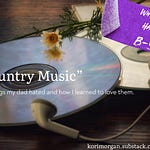Beginning when I was in eighth grade (around the same time that I first read Lolita) my dad started showing me his list of essential viewing for film lovers. I imagine that he must have been waiting for this moment, silently marking time until I was of the appropriate age to take in the great cinematic classics. We’d always gone to the movies together, but at some point, Disney movies and PG-rated comedies gave way to cerebral stories that required more mature thought.
I knew something had changed when one time I was home sick from school, he went to Blockbuster and came back not with cartoons or comedies but Howards End and The World According to Garp.
I don’t know if he specifically chose that year as the threshold of where this change took place. I only know I was fourteen when I first saw The Shawshank Redemption.
Sometime around the end of eighth grade, it aired on TNT. This wasn’t an unusual occurrence; my dad frequently referred to TNT as “The Shawshank Channel” because it seemed like it was the only movie they ever showed. (This wasn’t a complaint.)
Still, as we gathered on the lumpy gray couch in the basement to watch the movie, I sensed that this was a big deal. And it was. It truly was.
We watched the movie on a Sunday night, a school night, and after it ended, I couldn’t sleep. The combined weight of its shocking twist and sweeping, emotional final shot would not allow my brain to shut down. Andy Dufresne and Red followed me for weeks as the story settled into my mind and I could finally process the creativity behind it.
If you’ve seen the movie, you know what I’m talking about—it’s hard to get out of your mind. The story is so complex that you’re looking backward, trying to remember all the clues leading up to the big revelation, while also presently processing the story’s overall depth.
I won’t give any spoilers because everyone deserves to experience this masterpiece fresh. But I think The Shawshank Redemption is so iconic because, despite the darkness and brutality of the prison setting, the ending is such a decisive, unambiguous defeat of evil.
All that was wrong is made right in abundance. All that was sad becomes untrue.
In many ways, it reminds me of the end of Prince Caspian in the Narnia series. Freedom, reunions, and celebration unfold so brightly that they eclipse all the dark that came before.
I don’t think I’m spoiling anything by telling you this. Much of the movie is difficult to watch, and if anything, you will view the characters’ suffering in light of their coming joy.
But a few years after I first saw The Shawshank Redemption, life got hard. I began to struggle with depression. Painful family issues unfolded. During my junior year, the events of September 11 only worsened my already delicate mental health.
Moreover, school was miserable. It was so aggressively clear how much I didn’t belong. I was bullied and ostracized, and finally, I shut down and stopped even trying to connect with people.
All I wanted was to graduate, but that seemed so far off. My life was composed of academics and extracurricular activities I found rewarding while I marked time until all this would finally end.
When I felt hopeless, which was often, I watched The Shawshank Redemption. I realize it sounds like typical teenage melodrama to compare your relatively cushy life circumstances to a guy serving a life sentence for murder who is just trying to stay alive.
Still, Andy Dufresne resonated with me in the core of my soul. The further the story advances, the bolder and more desperate for survival he becomes. I felt weak, but his story showed me it didn’t have to be that way. And the ending—that utter explosion of beauty—demonstrated that this momentary affliction was temporary.
I wasn’t a Christian at that point. I mocked, rebelled against, and blasphemed God at every turn. But in His grace and sovereign love, He was planting seeds even then, giving me a word picture of what it means to hope.
At two crucial points in the story, Andy explains the significance of hope: “There’s something inside they can’t get to, that they can’t touch,” he tells a group of inmates. “Hope.”
He later expounds on this, famously adding, “Hope is a good thing. Maybe the best of things. And no good thing ever dies.”
Of course, being a nonbeliever, my source of hope in high school was a change in my earthly circumstances. But today, viewing the movie as a Christian whose hope is in the Lord and His Return, I see things differently.
It makes me think of Paul’s words in Romans 5:5: “Hope does not disappoint, because the love of God has been poured out within our hearts through the Holy Spirit who was given to us.”
No good thing ever dies, indeed.
It’s worth mentioning that I also am in a unique position regarding my love of this movie: I live an hour away from Mansfield, Ohio, where it was filmed.
Several years back, my parents and I visited the historic Ohio State Reformatory, where the exterior and some interior shots were staged. This experience brought the story to life for me and made subsequent viewings of the movie even more thrilling as I watched the actors move about in places I’d been.
In my forthcoming book, Why I Dyed My Hair Purple & Other Unorthodox Stories, one essay addresses my relationship with The Shawshank Redemption. In addition to its theme of hope, the story has a beautiful through-line about the role of art in the midst of suffering, which I address in detail.
I know many of you are anxiously awaiting information about how to pre-order the book and get involved with its release, and I’ll have details soon.
But for now, if you haven’t seen The Shawshank Redemption, consider experiencing my favorite movie. And if you have, it’s one that demands to be seen again.
In the meantime, drop your favorite movie in the comments. 😀















Share this post